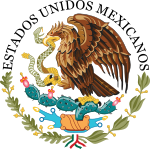This article needs to be updated. (July 2023) |
This article needs additional citations for verification. (March 2019) |
Politics of Mexico Política de México | |
|---|---|
 | |
| Polity type | Federal presidential constitutional republic |
| Constitution | Political Constitution of the United Mexican States |
| Legislative branch | |
| Name | Congress of the Union |
| Type | Bicameral |
| Meeting place | Legislative Palace of San Lázaro |
| Upper house | |
| Name | Senate of the Republic |
| Presiding officer | Gerardo Fernández Noroña, President of the Senate of the Republic |
| Lower house | |
| Name | Chamber of Deputies |
| Presiding officer | Sergio Gutiérrez Luna, President of the Chamber of Deputies |
| Executive branch | |
| Head of state and government | |
| Title | President |
| Currently | Claudia Sheinbaum |
| Appointer | Direct popular vote |
| Cabinet | |
| Name | Cabinet of Mexico |
| Leader | President |
| Appointer | President |
| Headquarters | National Palace |
| Ministries | 19 |
| Judicial branch | |
| Supreme Court of Justice of the Nation | |
| Chief judge | Norma Lucía Piña Hernández |
| Federal Electoral Tribunal | |
| Chief judge | Mónica Aralí Soto Fregoso |
 |
|---|
|
|
The politics of Mexico function within the framework of a federal presidential representative democratic republic whose government is based on a multi-party congressional system, where the President of Mexico is both head of state and head of government. The federal government represents the United Mexican States. It is divided into three branches: executive, legislative, and judicial, established by the Political Constitution of the United Mexican States, published in 1917. The constituent states of the federation must also have a republican government based on a congressional system established by their respective constitutions.[1]
Executive power is exercised by the executive branch, headed by the President, who is advised by a cabinet of secretaries independent of the legislature. Legislative power is vested in the Congress of the Union, a two-chamber legislature comprising the Senate of the Republic and the Chamber of Deputies. Judicial power is exercised by the judiciary, consisting of the Supreme Court of Justice of the Nation, the Council of the Federal Judiciary, and the collegiate, unitary, and district tribunals.
- ^ OECD (October 20, 2004). OECD Territorial Reviews: Mexico City 2004. OECD Publishing. ISBN 978-92-64-01832-7.